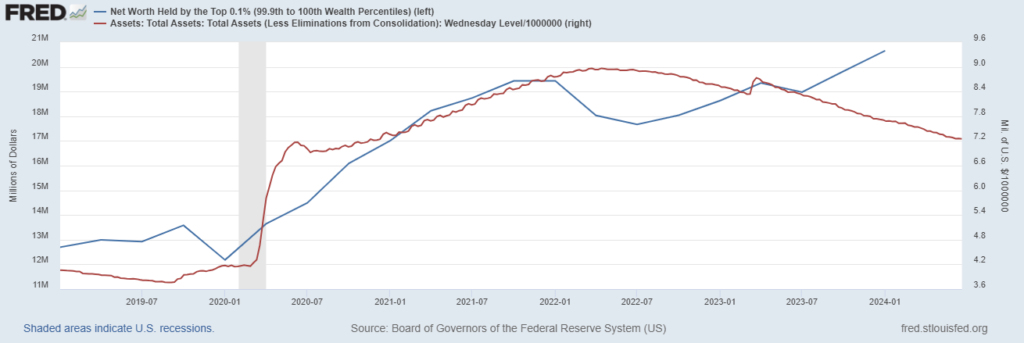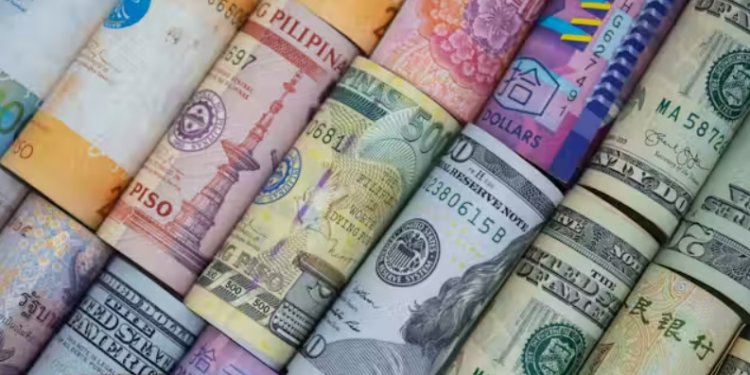Many people will remember the Covid policy response as a nightmare involving: reduced access to medical treatment, businesses closures, disrupted schooling and fear generated by Government brainwashing. After the event, it is always worth doing a ‘cui bono‘ (who benefits) exercise to identify who benefited, especially since the hopeless mainstream media have largely failed to do this.
Counterintuitively, the über-wealthy owners of 0.1% of wealth in the United States, increased their net worth by a staggering $6.4 trillion over the 2022-2023 pandemic period. With their net worth growing from $12.1 trillion to $18.5 trillion, a pretty cool $20 million per head for approximately 300,000 people. This outcome is counterintuitive since the lockdowns temporarily wrecked the economy and had a significant negative impact on Government debt, which ballooned due to staggering budget deficits. All things being equal, you would expect stock markets to move lower under these circumstances.
In the Alice-in-Wonderland world of extreme money printing though the stock market exploded and the benefit from this explosion accrued primarily to the über-wealthy, who hold most of the financial assets. Regular folk without significant financial assets tended to get left with the rough end of the stick in the form of elevated inflation. We covered the link between money printing and financial asset values in a previous note (‘Where did the money go?‘), the chart below shows that money printing (red), moves in almost exactly the same way as the size of the wealth owned by the wealthiest 0.1% (blue). Both axes are in trillion (millions of millions).

You could credibly argue that the aim of monetary policy seems to be to prop up the value of the financial assets held by the über-wealthy. Within the group of über-wealthy, gains were not evenly distributed. The world’s second richest man, Jeff Bezos, made over $90 billion in paper gains over the first nine months of 2020 due to an increase in Amazon’s share price. A large part of this was thanks to lockdowns, which closed down the bricks and mortar competitors and diverted tens of billions of dollars to Amazon, whose sales growth doubled from around 20% to 40% towards the end of 2020.
Another group which seemed pleased with the lockdowns was that of the social engineers who had since the 1970s wanted to redesign society, including to reduce or even eliminate growth. The Chairman of the World Economic Forum, Klaus Schwab co-authored a book, COVID-19:The Great Reset. The book calls for significant parts of the lockdown response to be made permanent; the book’s cover makes clear that he wanted to leverage Covid for the purposes of introducing massive societal change.
They say that you should never let a good crisis go to waste, but what if rather than waiting for a good crisis, some interest groups created or simply exaggerated a crisis?
One thing that has become clear over the recent past is that the über-wealthy have access to enormous lobbying power via their foundations. A large foundation can comfortably spend around $400 million a year on lobbying (philanthropy). As we discussed in our note on green money, the resources of the oligarch foundations dwarf the funding available to regular political parties.
In addition to having access to foundations, the über-wealthy have significant media reach in their own right. This is what several high profile business leaders said in 2020 about the coronavirus:
As we now know, the global infection fatality rate (IFR) was 0.03% for the under-60s: this was not the existential threat that it was made out to be. The fact that Covid was not an existential threat and that the infamous Imperial model was significantly overstated was clear from March 2020, as soon as the Diamond Princess figures came in. Professor Levitt identified that the Imperial model was massively overstated (I was able to help him correct some small errors in the calculations).
We can identify a small group of über– wealthy who on an ex-post basis enjoyed rapid and large increases in wealth as lockdowns favoured their businesses whilst disadvantaging competitors. Furthermore, the eye watering money printing significantly raised the value of pretty well all financial assets. Finally, a group of social engineers who wished to see a “Great Reset” involving reduced consumption also seemed well pleased with lockdowns, the WEF website carried gushing articles about the benefits of lockdowns.
It could be that the quotes above from Schwab, Soros and Gates were alarmist as they were made in the heat of the moment. I was always dubious about this explanation: Bill Gates’s quote was the earliest from February, but the others were later and after actual data were available. These individuals are very wealthy and must presumably be highly numerate and able to accurately assess risks. They would also have access to the best available researchers and sophisticated databases. It feels unlikely that they would get simple ratios significantly wrong, in my opinion.
In any event, a credible case could be made to say that some vested interest groups wanted to see a terrible overreaction to Covid, provided that this was accompanied by enough money printing. It is worth remembering that the pre-existing pandemic response plans explicitly excluded lockdowns as a policy option:
In other policy areas, I have noticed a pattern whereby high profile oligarchs float a policy idea, which subsequently becomes Government policy years later (more about this later).
I am not making accusations, but identifying interest groups that either benefited financially or achieved the policy response that they wanted.
Worryingly, the issue of lockdown effectiveness is being largely ignored, even though Professor Ioannidis et al. have convincingly shown that lockdowns achieved next to nothing. There is a danger that various interest groups are ensuring that this topic is not addressed so that they can repeat lockdowns in the future. Crime requires three elements and we have all three in lockdowns: motivation ($6.4 trillion increase in net worth), method (enormous lobbying resources) and opportunity (venal politicians). Is this too conspiratorial?
Alex Kriel is by training a physicist and was an early critic of the Imperial Covid model. He is a founder of the Thinking Coalition, which comprises a group of citizens who are concerned about Government overreach. This article was first published on the Thinking Coalition’s Substack. Subscribe here.













To join in with the discussion please make a donation to The Daily Sceptic.
Profanity and abuse will be removed and may lead to a permanent ban.
Did Bill Gates deny Event 201 happened early on, if so that needs investigating.
” Is this too conspiratorial? No and don’t forget the useful idiots.
Alex Kriel is simply putting a more mathematical explanation to the Scamdemic and very welcome it is too. What he tells us is what many here on DS had worked out for ourselves. It is important to make clear however that the C1984 scamdemic was but the opening salvo in a war that will be fought, at least by some of us, to the bitter end. The Davos Deviants have an initial end date of 2030 so we are only just four years in which means there is an awful lot more misery to come and probably starting this Autumn / Winter with a bird ‘flu pandemic which coincidentally will allow for a huge campaign of destruction against our farmers – foot and mouth v.2.
Indeed. I think the phrase “policy response” is used in the article. That’s not really how I think of what happened. What happened was framed as a “policy response” but it looked to me at the time and more so now as I reflect as a fictitious, manufactured “crisis” or “emergency”.
Absolutely tof
I think you are right much more to come, the Davos crowd do not believe that citizens have inalienable rights and that it is their job to Reset us.
A friend just told me that someone we know just “tested” “positive” for “Covid”. I’m sad that so many people still believe the BS.
My neighbour walked up the drive yesterday with a face nappy on to tell me his partner had died. He apparently “had Covid” and had not been out for a few days – more or less since she had died. The last thing he needed was to be mooching around at home alone. I did try to tell him not to worry on my account but it just didn’t register.
Authoritarian ideologies? Isn’t that conspiracy theory territory ? Police searching shopping bags for non essential goods? Harassing old people on park benches? Drones following hill walkers. What nonsense.
My son’s on-line busiess increased its turnover by 20% during the first year of lock-down. He sells hobby collectors’ modelling products that appeal mainly to men in their 20s and 30s. During this time he was able to provide employment to dozens of warehouse and packing staff entirely in accordance with the (b. stupid) rules.
The additional business has been sustained subsequently, so it would seem that a lot of younger people were looking for a creative pastime to while away the boring lock down and got hooked.
Yes, it is hardly surprising that Jeff Bezos made a fortune. With everybody stuck at home, it is clear that mail-order companies would make a big profit.
And Netflix!